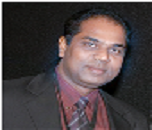Sessions & Tracks
Session1:2D Materials Beyond Graphene
One of the trending topics in the field of nanoscience and nanotechnology is the exploration of 2D materials beyond graphene. While graphene, a single layer of carbon atoms arranged in a hexagonal lattice, garnered significant attention for its remarkable properties, researchers are now focusing on other 2D materials with unique characteristics. MXenes, a family of 2D transition metal carbides and nitrides, exhibit excellent electrical conductivity and electrochemical properties. Phosphorene, a single layer of black phosphorus, is suitable for flexible electronics and optoelectronics due to its unique properties, including anisotropic behavior and a tunable bandgap. These materials offer diverse opportunities for innovation and the development of new nanoscale devices and technologies, making them a prominent area of research in nanoscience and nanotechnology.
Session2:Nanomedicine for Targeted Therapies
Nanomedicine for targeted therapies is a prominent field in nanoscience and nanotechnology. It involves using nanoscale materials and techniques to enhance the delivery of drugs and therapeutic agents to specific cells or tissues within the body. This approach offers several significant advantages:
-
Drug Delivery
-
Imaging and Diagnostics
-
Therapeutic Agents
-
Hyperthermia
-
Gene Therapy
Session3: Quantum Nanoscience
Quantum nanoscience is an interdisciplinary field that combines quantum physics and nanoscience to study and manipulate quantum phenomena at the nanoscale. It involves the exploration of materials and devices with unique quantum properties and aims to harness these properties for various applications. Key areas of focus include quantum dots, nanoelectronics, quantum computing, spintronics, quantum sensors, novel quantum materials, quantum optics, quantum sensing in biology, quantum communication, and quantum metrology. This field holds the potential to revolutionize technologies across various sectors by leveraging the behavior of matter and energy at the quantum level.
Session4: Immunotherapy
Immunotherapy, an innovative medical approach, has seen remarkable advancements with the integration of nanoscience and nanotechnology. These fields work together to enhance the precision, efficiency, and effectiveness of immunotherapeutic strategies.Nanotechnology facilitates targeted drug delivery through the development of nanoparticles capable of transporting immunotherapeutic agents with precision. This minimizes collateral damage to healthy tissues, improves drug stability, and enhances treatment outcomes.Cancer immunotherapy can deliver immune checkpoint inhibitors and antigens directly to tumor sites, helping to overcome the suppressive tumor microenvironment and bolster the body's immune response against cancer cells.
Session5: Nanotechnology in Agriculture
Nanotechnology in Agriculture Nanotechnology is increasingly playing a pivotal role in modern agriculture, offering innovative solutions to enhance crop production, resource management, and food quality. Through the manipulation of materials at the nanoscale, agriculture is benefiting in various ways. Nanosensors and nanosatellites provide real-time data for precision agriculture, enabling farmers to optimize resource allocation and increase crop yields while reducing waste. Nanofertilizers and nanopesticides are improving nutrient and pest management, leading to more efficient and sustainable farming practices. Additionally, nanotechnology aids in soil remediation, water purification, and livestock health, contributing to overall agricultural sustainability. However, it is crucial to address potential environmental and safety concerns and ensure responsible regulation in the integration of nanotechnology in agriculture.:
Session6: Nanosensors and Diagnostics
Nanosensors and diagnostics represent a remarkable frontier in scientific and medical advancement. These technologies, enabled by nanotechnology, have the potential to transform healthcare, environmental monitoring, and various industries. By exploiting the unique properties of nanomaterials, nanosensors can detect minuscule quantities of target substances with exceptional sensitivity and specificity. In medicine, they offer the promise of early disease detection and personalized treatment plans, improving patient outcomes and reducing healthcare costs. Additionally, nanosensors play a critical role in environmental protection by monitoring pollutants and enabling swift responses to emerging threats. As nanotechnology continues to evolve, nanosensors and diagnostics are poised to make substantial contributions to our understanding of the world around us and our ability to address complex challenges. However, ongoing research and regulatory oversight are essential to ensure their safe and responsible integration into various applications.
Session7: Nanotechnology in Space Exploration
Nanotechnology is poised to revolutionize space exploration by offering innovative solutions to the unique challenges faced in the extreme conditions of outer space. With the manipulation of materials at the nanoscale, space agencies and researchers are exploring several key applications. Nanomaterials are being employed in the development of lightweight and durable spacecraft components, enabling faster and more cost-effective space travel. Nanosensors are aiding in the monitoring of spacecraft health, detecting potential issues and ensuring mission success. Additionally, nanotechnology is enhancing energy storage solutions, making long-duration missions and solar power generation in space more efficient. As space exploration continues to expand, nanotechnology promises to play a pivotal role in advancing our understanding of the cosmos and expanding our capabilities beyond Earth's boundaries.
Session8: Bioinspired Nanotechnology
Bioinspired nanotechnology, at the convergence of biology and nanoscience, offers a remarkable avenue for innovation. By emulating the designs and processes found in nature, it opens doors to groundbreaking applications across diverse fields. Researchers draw inspiration from biological structures, functions, and even molecular processes to engineer nanoscale materials and devices. This approach has led to remarkable advances in fields such as medicine, materials science, and energy. For example, nanoparticles that mimic the behavior of cells can deliver drugs precisely to disease sites, enhancing treatment efficacy while minimizing side effects. Moreover, the use of biological templates, like DNA origami, has enabled the creation of nanoscale structures with incredible precision. As bioinspired nanotechnology continues to evolve, it holds immense promise for solving complex problems and improving the quality of life in numerous ways, from healthcare to environmental sustainability.
Session9: Nanotechnology for Environmental Remediation
Nanotechnology is playing a pivotal role in environmental remediation, offering innovative solutions to address pollution and contamination challenges. By harnessing the unique properties of nanomaterials, researchers and engineers are developing effective and sustainable approaches to clean up contaminated soil, water, and air. Nanoscale materials, such as nanoparticles and nanotubes, can adsorb, degrade, or immobilize a wide range of contaminants, including heavy metals, organic pollutants, and hazardous chemicals. Additionally, nanotechnology-enabled sensors and monitoring systems provide real-time data, enhancing our ability to detect and respond to environmental threats promptly. As the world faces increasingly complex environmental issues, nanotechnology offers a promising pathway to mitigate pollution and restore ecosystems, contributing to a cleaner and more sustainable planet.
Session10: Nanotechnology and Artificial Intelligence (AI)
The convergence of nanotechnology and artificial intelligence (AI) represents a transformative synergy with vast implications for various industries. Nanotechnology, operating at the nanoscale, enables the precise manipulation of materials and the creation of nanoscale structures and devices with unique properties. AI, on the other hand, excels in processing massive amounts of data, pattern recognition, and making informed decisions.The fusion of nanotechnology and AI is driving innovation at an unprecedented pace, with the potential to address complex global challenges, from healthcare to sustainable energy, and reshape the way we interact with the physical world.
Session11: Nanotechnology in Wearable and Flexible Electronics
Nanotechnology has ushered in a new era of wearable and flexible electronics, transforming the way we interact with technology. Flexible nanomaterials like graphene and carbon nanotubes are at the forefront of this innovation, enabling the creation of electronic components that are not only incredibly flexible but also highly conductive. These materials form the basis for wearable sensors that can monitor vital signs and health parameters, enhancing personalized healthcare and fitness tracking. Additionally, nanotechnology has facilitated energy harvesting at the nanoscale, with nanogenerators converting mechanical energy from body movements into electricity to power these devices. As a result, the integration of nanotechnology into wearable and flexible electronics has led to the development of more comfortable, lightweight, and efficient devices that are reshaping industries ranging from healthcare to fashion, with promising potential for further breakthroughs in the future.


